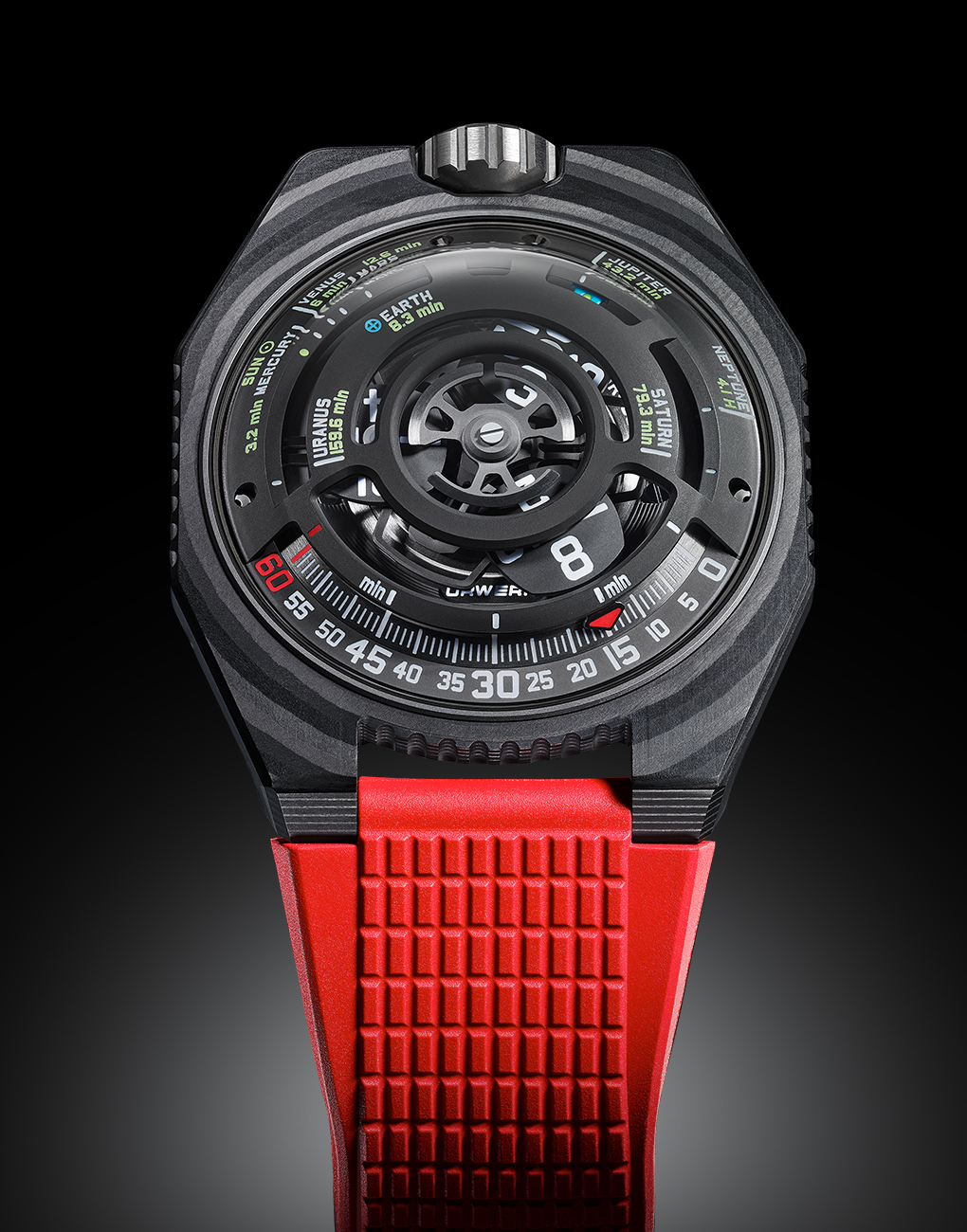SpotlightGodspeed! The New Urwerk 100-V LightSpeed Timepiece
The LightSpeed showcases a new horological invention by Urwerk of displaying the time it takes a sun's ray to travel to celestial bodies of the solar system
May We Recommend
The latest UR-100V LS (LightSpeed) timepiece by Urwerk, unveiled today, is indicative of how far we have come with research regarding the spheres of modern physics and planetary science. Danish astronomer Ole Christensen Rømer in 1676 was the first to discover that light travels at a finite speed, followed by English physician James Bradley who used the movement of stars to calculate the speed of light at 295,000 km. It was only in 1983 that a group of scientists calculated the speed of light in a vacuum, the universal constant denoted as ‘c’, equivalent to 299,792.458 km/s (about 300,000 km/s; 186,000 mi/s; 671 mn mph). Decades later, the Urwerk LightSpeed has physically demonstrated the speed of light between eight planetary bodies, by encompassing a miniature solar system on its black dial. With ‘c’ forming the crux of LightSpeed, the timepiece is an ode to Albert Einstein’s Theory of Relativity, and also celebrates the galactic pursuits of the Star Wars Jedi, the Star Trek captains, the Goa’uld tacticians in Stargate, and also the Spacing Guild navigators in Dune.

LightSpeed: New Kid On The UR-100V Block
Urwerk has gained repute for its futuristic designed timepieces heavily influenced by science-related themes, observed right from its oldest series UR-100. Its UR-100V series feature the iconic orbital hour satellites (or wandering hour carousel) with minute pointers at the base shaped as a wide grin. The mainstay of the UR-100V series are notable sci-fi themed watches such as the shimmery diamond-studded UR-100V Stardust, the smooth sandblasted fully titanium wonder UR-100V Magic T, and the attempt to capture the purplish luminous essence with the UR-100V Ultraviolet. Joining this lineup is the UR-100V LS, appearing like a continuum of the UR-100 SpaceTime, which juxtaposes home time with three distance-based measurements: the kilometres we have travelled on the Earth based on the average speed of the Earth’s rotation on its axis (555 km every 20 minutes) and the distance the Earth has orbited around the sun (35,740 km every 20 minutes).
Measuring Planetary Distances With LightSpeed
The Urwerk LightSpeed, along with the home time, displays the time that the same sun’s ray takes while travelling from the Sun to individual, planets, staggered to indicate their position on different orbital paths. Acting as ‘cue cards’, the dial shows the sun ray reaches Mercury in 3.2 minutes, Venus—6 minutes, Earth—8.3 minutes, Mars—12.6 minutes, Jupiter—43.2 minutes, Saturn—79.3 minutes, Uranus—159.6 minutes and Neptune—4.1 hours. A separate slow-moving hand represents the speed of light travelling to all the planets, in tandem with the red-tipped minute indicator. “Light serves as our connection to the Universe, representing the smallest unit of energy capable of being transmitted. Its electromagnetic radiations are precisely in the range that our eyes are attuned to detect. This ability to visualise and interpret this information reconstructs our perception of the world. Whether gazing at distant stars or peering through a microscope, light conveys essential details shaping our understanding of reality, continually expanding our knowledge and comprehension of the vast and intricate universe around us,” said Urwerk co-founder and artistic director Martin Frei in a press statement.

Powering the UR-100V LightSpeed, is the same iconic UR 12.02 calibre that runs rest of the UR-100V family, beating at 28,800vph, and offering up to 48-hour power reserve. Visible through the caseback is the self-winding in-house movement features a bidirectional black PVD-treated aluminum rotor—regulated by a Windfänger airscrew and planetary turbine automatic system—to moderate the rotational speed limit and prevent it from spinning out of control if the watch experiences shock when worn during high activity. Fitted with 40 jewels and chamfered screw heads, the movement features multiple surfaces decorated in circular graining, sandblasting, shot-blasting, and circular satin finishing techniques.
The innovation in display of time and extraterrestrial distances comes enclosed within the robust 43mm case made primarily from grade-5 titanium, adorned with 54 fine layers of black carbon DLC coating, sand and shot-blasted finish as a testament to exquisite watch craftsmanship. Matching the red tipped minute pointer and Arabic 60-minute marker comes fitted with a red textured rubber strap and folding clasp.
The Urwerk LightSpeed presents the opportunity to get lost in worlds, space and time beyond our limited understanding, offering the chance to see and quantify what is unfathomable to the human eye, proving anything is possible, like reducing the entire solar system to fit on your wrist.







Beautiful watch